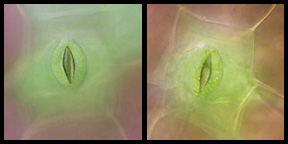Biology: Plant Hormones, Nutrition, and Transport: Part One
Guard Cells Regulate Transpiration
When we turn on a garden hose, we have some method by which we regulate the flow of water through that hose – the faucet valve. How can plants regulate the flow of water through their xylem? If there were no regulatory mechanism, the plant would simply soak all the water from the soil and transpire it from the open stomata in its leaves.
In most environments, the water concentration outside the leaf is less than that inside the leaf. This causes a loss of water through the leaf openings (stomata). Guard cells are crescent-shaped cells of the epidermis that flank each stoma and regulate the size of the opening. Together, the guard cells and stoma comprise the stomata apparatus. The inner wall of the guard cell is thicker than the rest of the wall. When a guard cell takes up potassium ions, water moves into the cell. This causes the cell to become turgid and swell, opening the stoma. When the potassium ions exit the guard cell, the water also leaves, causing plasmolysis of the cells. The stoma closes. The movement of these ions into and out of the guard cells is regulated by the plant hormone abscisic acid. Stomata occupy 1 percent of the leaf surface (usually the lower epidermal surface) but account for 90 percent of the water lost in transpiration.

Closed and open stomata.
The movement of ions and water (regulated by plant hormones) causes the guard cells to shrink or expand as they regulate the size of the stoma.
Transportation and storage of nutrients
One of the uses plants have for the water delivered by the xylem to the leaves is photosynthesis, the converting of carbon dioxide and water into sugar and oxygen. Plants make sugar by photosynthesis, usually in their leaves. Some of this sugar is directly used for the metabolism of the plant leaves, some for the synthesis of proteins and lipids, and some is stored as starch. Other parts of the plant, such as the roots, also need energy but are not photosynthetic. Food (in the form of sugar) must therefore be transported into those areas from the leaves. This transport is accomplished by the other vascular tissue, the plant’s phloem.
Now go on to the next part. 
|